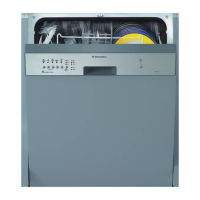Do you have a question about the Electrolux ESI 6241 and is the answer not in the manual?
Guidelines for safe installation, connection, and initial operation of the dishwasher.
Precautions to prevent children from accessing or playing with the dishwasher.
Essential safety rules for operating and maintaining the dishwasher.
Instructions on proper usage to avoid damage and ensure optimal performance.
How to use the safety catch to prevent accidental door opening by children.
Guidance on the correct disposal of packaging material and old appliances.
Tips for efficient and environmentally friendly dishwashing practices.
Explanation of the control panel buttons, displays, and indicators.
Steps to follow before the first use, including adjustments and filling.
How to adjust the water softener based on local water hardness.
Information on using and adding special salt for the water softener.
Step-by-step guide for refilling the salt container.
When and how to add rinse aid, and when to deactivate its supply.
Instructions on activating or deactivating the rinse aid dispensing system.
Detailed steps for refilling the rinse aid dispenser.
How to modify the amount of rinse aid dispensed for optimal drying.
Best practices for arranging dishes and cutlery for effective washing.
Proper placement of cutlery in the rack or basket for thorough cleaning.
Tips for loading pans, frying pans, and large plates in the lower rack.
How to load delicate items like cups, glasses, and coffee services.
How to raise or lower the upper basket for better space utilization.
Instructions for correctly filling the detergent dispenser.
Advice on using combination detergent tablets and their functions.
Information on concentrated detergents and their optimal use with 50°C programs.
Notes on how different detergent tablets dissolve and their suitability for short programs.
How automatic programs adjust water and temperature based on load and soiling.
A table to help choose the most suitable wash program for different dish types and soiling.
Step-by-step guide to initiating a wash program.
How to change, interrupt, or abort an ongoing dishwashing cycle.
How to set or change the delayed start timer for wash programs.
Explanation of how the dishwasher automatically adjusts settings for small loads.
Correct procedure for turning off the appliance after a cycle.
Recommended method for unloading dishes to prevent damage and water marks.
Detailed instructions for removing and cleaning the filter system.
Guide to interpreting error codes and flashing indicators on the control panel.
Solutions for issues like the program not starting or rust spots.
Tips to address dirty, wet, or streaky dishes and improve drying.
Requirements and steps for physically installing the dishwasher.
Details for integrating the dishwasher behind a furniture door.
Specific instructions for installing built-in models.
Guidelines for setting up the dishwasher as a standalone unit.
Overview of essential plumbing and electrical connections for the appliance.
How to connect the water supply hose to the tap.
Information on acceptable water pressure ranges for operation.
Proper methods for connecting the water inlet hose, including nut tightening.
Details on the water inlet hose with a safety valve and its installation.
Instructions for connecting the drain hose to plumbing or a wash basin.
Guidelines for drain hose length, height, and preventing kinks.
Information on using extension hoses for the drain or water inlet.
How to connect the drain hose to a siphon.
Method for draining water into wash basins using an elbow.
How the appliance's leak prevention system works to prevent water damage.
Safety and technical requirements for connecting the dishwasher to mains power.
Diagram showing water inlet, drain, and mains cable connections.
Guidelines for safe installation, connection, and initial operation of the dishwasher.
Precautions to prevent children from accessing or playing with the dishwasher.
Essential safety rules for operating and maintaining the dishwasher.
Instructions on proper usage to avoid damage and ensure optimal performance.
How to use the safety catch to prevent accidental door opening by children.
Guidance on the correct disposal of packaging material and old appliances.
Tips for efficient and environmentally friendly dishwashing practices.
Explanation of the control panel buttons, displays, and indicators.
Steps to follow before the first use, including adjustments and filling.
How to adjust the water softener based on local water hardness.
Information on using and adding special salt for the water softener.
Step-by-step guide for refilling the salt container.
When and how to add rinse aid, and when to deactivate its supply.
Instructions on activating or deactivating the rinse aid dispensing system.
Detailed steps for refilling the rinse aid dispenser.
How to modify the amount of rinse aid dispensed for optimal drying.
Best practices for arranging dishes and cutlery for effective washing.
Proper placement of cutlery in the rack or basket for thorough cleaning.
Tips for loading pans, frying pans, and large plates in the lower rack.
How to load delicate items like cups, glasses, and coffee services.
How to raise or lower the upper basket for better space utilization.
Instructions for correctly filling the detergent dispenser.
Advice on using combination detergent tablets and their functions.
Information on concentrated detergents and their optimal use with 50°C programs.
Notes on how different detergent tablets dissolve and their suitability for short programs.
How automatic programs adjust water and temperature based on load and soiling.
A table to help choose the most suitable wash program for different dish types and soiling.
Step-by-step guide to initiating a wash program.
How to change, interrupt, or abort an ongoing dishwashing cycle.
How to set or change the delayed start timer for wash programs.
Explanation of how the dishwasher automatically adjusts settings for small loads.
Correct procedure for turning off the appliance after a cycle.
Recommended method for unloading dishes to prevent damage and water marks.
Detailed instructions for removing and cleaning the filter system.
Guide to interpreting error codes and flashing indicators on the control panel.
Solutions for issues like the program not starting or rust spots.
Tips to address dirty, wet, or streaky dishes and improve drying.
Requirements and steps for physically installing the dishwasher.
Details for integrating the dishwasher behind a furniture door.
Specific instructions for installing built-in models.
Guidelines for setting up the dishwasher as a standalone unit.
Overview of essential plumbing and electrical connections for the appliance.
How to connect the water supply hose to the tap.
Information on acceptable water pressure ranges for operation.
Proper methods for connecting the water inlet hose, including nut tightening.
Details on the water inlet hose with a safety valve and its installation.
Instructions for connecting the drain hose to plumbing or a wash basin.
Guidelines for drain hose length, height, and preventing kinks.
Information on using extension hoses for the drain or water inlet.
How to connect the drain hose to a siphon.
Method for draining water into wash basins using an elbow.
How the appliance's leak prevention system works to prevent water damage.
Safety and technical requirements for connecting the dishwasher to mains power.
Diagram showing water inlet, drain, and mains cable connections.
| Type | Freestanding |
|---|---|
| Number of Place Settings | 12 |
| Energy Efficiency Class | A |
| Noise Level | 51 dB |
| Dimensions (HxWxD) | 850 x 600 x 600 mm |
| Delay Start | Yes |
| Washing Class | A |
| Half Load Option | Yes |











